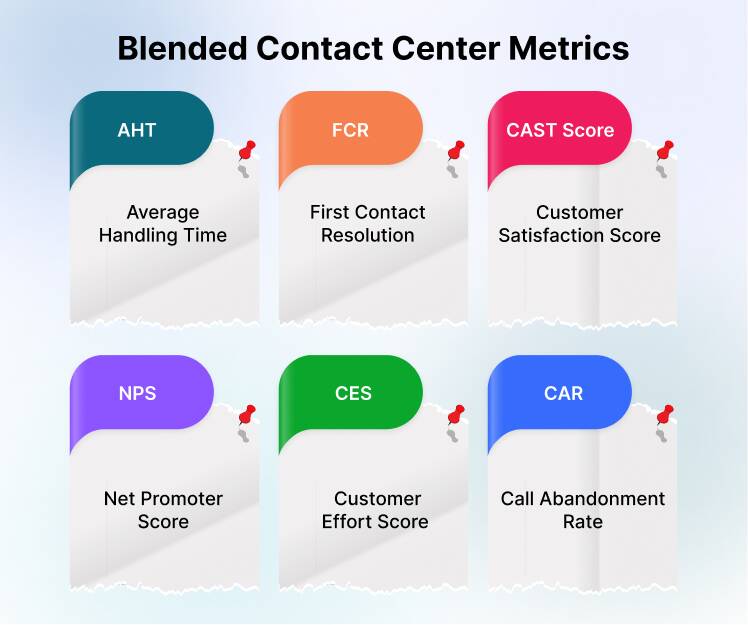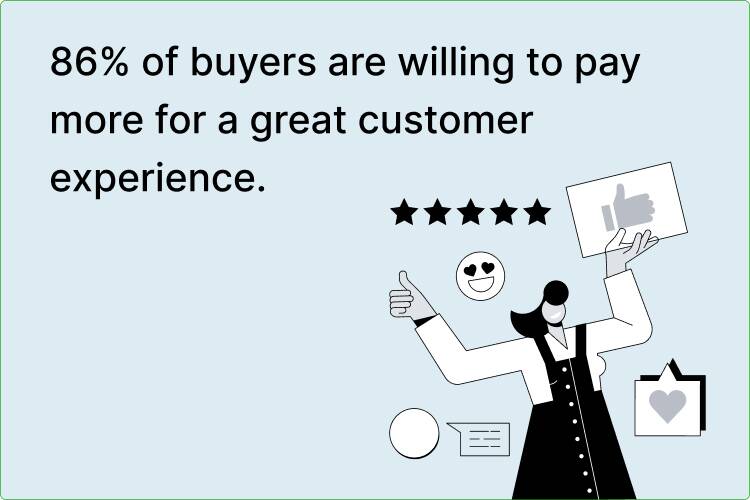
The traditional models of customer service are undergoing a rapid transformation. The emergence of blended contact centers is proof of this statement. A blended contact center is a dynamic approach that combines the best of both worlds. By seamlessly integrating inbound and outbound interactions, these centers offer improved customer experiences, boosted agent productivity, and optimized operational efficiency.
And there’s even more to discover!
Through this blog post, we aim to help you gain a deep understanding of blended contact centers. We will explore the features, benefits, challenges, setup procedures, and best practices for running a successful blended contact center.
Let’s dive in!
What is a Blended Contact Center?

A blended contact center is a system that allows contact center agents to handle both inbound and outbound customer interactions. The simplest setup offers basic two-way calling where agents can make and receive calls. However, advanced systems offer full omnichannel capabilities, where agents can handle customer interactions through multiple channels. Usually, this includes phone calls, emails, live chat, social media messaging, etc., all from a single platform.
A key component of a blended contact center is call blending. This strategy defines how both the inbound and outbound calls should be handled within a single contact center environment. In essence, call blending is about maximizing agent utilization and delivering better customer experiences.
Overall, a blended contact center combines the functionality of inbound and outbound call centers along with the integration of other digital channels. In such an environment, agents need not wait for customers to approach them, rather, they can proactively check in with customers, thus tailoring outreach based on past interactions and needs.
Interesting Insight – Companies that excel in customer experience can grow revenue by 4-8% above their market, according to Bain & Company. Did you know?
Now you may ask, are blended agents the same as call center agents? Well, the answer is that they do have similarities, but blended agents possess unique skills.
Suppose an agent who is proficient at handling inbound calls is not able to make outbound calls. An agent who is good at speaking to customers might struggle to write professional emails. So, it takes a unique skill set to become a blended contact center agent. Of course, it requires exclusive screening and training to prepare agents to handle multiple communication channels, offering greater flexibility and efficiency in managing customer interactions.
Blended Contact Center Examples
Various businesses and industries worldwide have implemented and benefited from blended contact centers. Let’s see some practical examples:
Telecommunication Companies
Suppose a customer with a connectivity issue contacts the blended contact center of the telecom company. The agents diagnose the issue and then proactively reach out to other customers in the same area to check if they’re experiencing similar issues. This approach could potentially help prevent a wider outage.
Travel Agencies
A customer sends a message via social media to inquire about their upcoming adventure trips. The agent replies with detailed information and then follows up with a call to confirm their booking.
Healthcare Providers
A healthcare provider uses a blended contact center for incoming calls about appointments or medication inquiries. It also uses the system to remind patients about upcoming checkups via outbound calling. Thus using an integrated approach to boost patient satisfaction and healthcare outcomes.
We can see that by merging inbound and outbound interactions, contact center agents gain a broader scope, reach more customers, and offer personalized experiences to customers throughout their journey.
Key Features of a Blended Contact Center
Blended contact centers come packed with various powerful features that enable agents to boost their efficiency and enhance customer satisfaction.
Let’s learn about some of the key features of a blended contact center.
Inbound Call Management
-
Automatic Call Distribution (ACD)
ACD works in the background. As an incoming call arrives, the Automatic Call Distribution system automatically routes the calls to agents or teams based on pre-defined factors like agent expertise, workload, availability, or customer needs.
-
Interactive Voice Response (IVR)
The IVR system is the first point of contact for all incoming calls. It welcomes callers with a pre-recorded audio message, offers them various self-service options for basic inquiries, and directs them to an appropriate department or agent. In short, it efficiently does all the work of a human receptionist.
-
Skills-Based Routing
This feature matches the nature of customer inquiries with the skills of the agents and routes the call to the agent who has the best knowledge about that specific issue. Skills-based routing significantly increases the likelihood of resolving the issue faster.
Outbound Calling Capabilities
-
Predictive Dialer
Blended contact center solutions with predictive dialing capabilities offer immense value to outbound campaigns. A predictive dialer implements algorithms to anticipate the availability of agents and automatically dials multiple customer contact numbers. Agents are connected to the call only when the receiver answers, thus increasing call volume and agent productivity.
-
Power Dialer
A power dialer is a more basic dialer system that automatically dials the next customer contact number on the list as soon as the current call finishes. Here, agents have more control over the dialing process, i.e., they can control the dialing speed or rate and dispose of unwanted calls such as busy signals.
-
Progressive Dialer
The progressive dialing approach is based on the automatic dialing of the next phone number as soon as an agent becomes available after a call. In simple words, the dialer dials one number at a time, and calls are made sequentially as agents become available. However, here, the agents have no control over the dialing process, i.e., calls are dialed automatically by the system.
-
Preview Dialer
Power dialers are quite useful for contact center agents, as the agents have a review window of 10-30 seconds i.e. customer information is displayed on their screen. The agent then decides whether to call the number or skip to the next one. This gives agents control over the calling process and allows them to prepare for each call.
Omnichannel Communication
-
Email Management
A blended contact center platform with email integration enables the agents to receive and respond to customer emails directly from within the platform.
-
Web Chat
Integrated web chat provides real-time chat assistance for customers seeking immediate help through the website or the mobile app.
-
Social Media Integration
This feature allows blended agents to monitor and respond to customer messages across various social media platforms.
Additional Features
-
Call Monitoring and Recording
By monitoring calls in real-time, managers can track agent activity, call volume, and performance metrics to optimize the contact center management process. Calls can be recorded and stored for training, quality assurance, and dispute resolution, which proves invaluable for successful contact center operations.
-
CRM Integration
This feature allows you to seamlessly connect your Customer Relationship Management System i.e. CRM system, with the blended contact center solution. It helps your agents gain a unified view of customer data, which is of great value during phone calls. As agents get access to customer details, they can understand customer requirements in a better way and deliver personalized responses.
-
Real-Time Analytics and Reporting
This feature provides insights into customer interactions, agent performance, metrics such as average call handling time, and the overall performance of the contact center.
It is important to note that the specific features offered by a blended contact center platform will vary depending on the service provider.
What are the Benefits of a Blended Contact Center?
Blended contact centers go beyond conventional inbound and outbound call center setups. They enable contact centers to create a seamless experience for both customers and agents. Let’s learn how a blended approach can change the game of customer service.
From ‘Frustrated’ to ‘Happy Customers’

Customers crave convenience and choice. A recent study reveals that 70% of customers are more inclined to purchase from brands that provide outstanding support through multiple channels.
Blended contact center agents have access to tools to handle multiple communication channels, such as phone calls and emails. So no matter through which channel your customers are trying to connect, agents can respond without any hindrance. This helps in minimizing wait times and improving customer happiness.
And that’s not all. Customers do not need to repeat themselves to agents across different channels. They can seamlessly switch between phone, chat, and email and still receive a consistent experience.
From ‘Clueless’ to ‘Productive Agents’
Blended agents become experts at handling customer inquiries from multiple channels. Using their blended contact center solution, they can handle customer issues efficiently and even upsell relevant products and services – all from a single platform.
Moreover, they have the fantastic opportunity to work in a dynamic environment where they can seamlessly switch between responding to a complex email and making a quick follow-up call. They are not stuck with repetitive tasks, which boosts engagement, efficiency, and motivation.
From Uneven to Optimized Operations
With blended contact center platforms, managers need not make guesswork about staffing levels. They have real-time insights about estimated call volume and agent availability. Having access to such data enables managers to ensure that the right amount of staff is on hand, especially during peak hours.
Moreover, the need to manage separate inbound and outbound teams is eliminated with blended agents, leading to more streamlined operations.
From ‘Guesswork’ to ‘Data-Backed’ Decisions
Blended contact center solutions capture valuable data across multiple communication channels. This helps managers understand customer behavior, identify areas for improvement, and deliver personalized experiences. Rather than flying blind, managers can make data-driven decisions about various aspects, such as resource allocation and customer service strategy.
Challenges of Running a Blended Contact Center
Like every technology, product, or service, blended contact centers aren’t without hurdles. Let’s explore these challenges and discover strategies to overcome them.
Intense Agent Training and Skill Development
The Challenge
A blended contact center environment demands dynamic agents that can easily switch between inbound and outbound interactions. Certainly, such a role requires a broader skillset. For example, agents who are comfortable with phone calls might not be good at email or chat.
The Solution
Blended contact center managers may consider investing in comprehensive training programs. This will equip agents with the knowledge and the necessary skills to handle multiple communication channels effectively. Role-playing exercises are a popular way to simulate practical scenarios and foster confidence among agents.
Measuring Performance Across Channels
The Challenge
Transitioning to a blended contact center demands more than simply adding new responsibilities to agents. Managers need a robust reporting system that offers valuable insights on various performance metrics, including average handle time, first-call resolution rate, average after-call work time, occupancy rate, customer satisfaction score, etc.
The Solution
Invest in a blended contact center solution with comprehensive reporting capabilities across multiple communication channels.
Potential for Agent Burnout
The Challenge
The constant pressure of switching between tasks and handling diverse customer queries can be a reason for agent fatigue and decreased motivation.
The Solution
Promoting a healthy work-life balance by inculcating flexible scheduling options, regular breaks, and gamification elements are some effective ways to maintain agent engagement.
Blended Contact Center Metrics to Measure

Compared to traditional inbound or outbound call center setups, blended contact centers demand a broader approach to measuring success across different channels. Take a look at the key metrics to monitor.
Average Handling Time or AHT
This metric measures the average time spent by agents handling customer interactions. Usually, this includes talk time, hold time, as well as after-call work.
First Contact Resolution or FCR
This is the percentage of inquiries resolved by agents during the first customer interaction. A good FCR is on the higher side, indicating efficient problem-solving.
Customer Satisfaction or CSAT Score
This metric measures customer sentiment after the call is over. Usually, surveys or rating systems are used to gather customer feedback about their experience with agent helpfulness, issue resolution, etc.
Net Promoter Score or NPS
This score measures the loyalty and willingness of customers to recommend your business or company. Of course, a high NPS indicates a positive customer experience.
Customer Effort Score or CES
This metric helps in evaluating the ease with which customers were able to resolve their queries. Tracking this metric can help you identify customer pain points.
Call Abandonment Rate or CAR
It is the percentage of calls where callers hang up before connecting with an agent. A high call abandonment rate is an indication that your customers are facing longer wait times.
How to Set Up a Blended Contact Center?

So far, we have learned that blended contact centers streamline operations, empower your agents, and ultimately elevate the customer experience. Let’s see how you can set up a blended contact center system.
Assess Your Current Infrastructure
Since a blended contact center solution is going to be a part of your existing contact center setup, it is important to evaluate your existing tools and technologies. This includes your CRM system and other such tools.
Choose the Right Blended Contact Center Software
While researching, focus on their functionalities. Consider useful features like automatic call distribution, skills-based routing, analytics and reporting, and integration with existing systems. Also, ensure the software is flexible and scalable to adapt to your contact center’s changing call volume.
Configure Your New Software
Your first step should be to migrate your existing customer data and call recordings to the new software. You can get the help of your software provider or an IT team for a smooth transition. After this, you may start configuring your new system to suit your needs. Customize the system by setting up the following:
- Routing rules
- Skill-based assignments for agents
- Integrating the platform with your CRM
Develop Customer Journey Maps
The journey of your customers in different scenarios is an important step. This helps you get a clear understanding of potential customer interaction across various touch points. Agents can thus deliver a more consistent and personalized experience.
Designate Roles and Responsibilities
First, determine the team structure of your blended contact center. The next step is to assign access and routing. Assign agent IDs and provide secure login credentials for each agent so that they can access the software. Configure the platform to display relevant information for each agent based on their role.
Setup Your IVR
Configuring an Interactive Voice Response system usually follows a series of steps :
- Create a clear and concise welcome message for your callers.
- Develop a well-structured menu with easy-to-understand options. You may consider multi-level menus for complex inquiries.
- Configure your IVR to handle basic or repetitive inquiries such as booking appointments, checking order status, etc.
Optimize your ACD
Create a clear plan for handling calls that arrive after business hours. You may route calls to the voicemail system or direct callers to a pre-recorded message with relevant information.
Perform Pilot Testing
Before a full rollout, running a pilot test program with a small group of agents can help identify and address potential issues.
Monitor and Optimize
Continuously monitor key performance indicators (KPIs) after launching the blended contact center. Analyze the data to identify areas for improvement, refine workflows, and optimize agent scheduling based on call volume trends.
Blended Contact Center Solution Best Practices
Practice “Customer First” Approach

Define standard processes for handling customer inquiries, regardless of the channel from which the customer arrives. Offer personalization by leveraging customer interaction history. Address them by name, give suggestions, or make recommendations based on past purchasing behavior. Practice a proactive outreach to boost customer engagement.
Ask for Customer Feedback Regularly
A robust customer feedback mechanism is a must to evaluate the real performance of your contact center. You can simply implement this mechanism by asking for ratings at the end of calls or conducting outreach campaigns to gather their feedback.
Invest in a Robust and Intuitive Solution
Blended contact center software isn’t just about basic call handling. Modern solutions come packed with powerful features that elevate the customer experience to another level. For example, a manager uses a “call whispering” feature to discreetly guide an agent during a live call. Such effective utilization of technology ensures a smooth resolution to customers’ concerns.
Wrapping Up!
The impact of poor customer service is undeniable. A staggering 70% of customers have walked away from a company due to bad experiences, according to American Express.
So, let’s rewind from the beginning.
Your ultimate goal is higher customer satisfaction and agent efficiency. Blending the capabilities of inbound and outbound contact center tools, a blended contact center adds immense value to various businesses, including telecom companies, travel agencies, and healthcare facilities. With features like ACD, IVR, dialing capabilities, CRM integration, real-time monitoring, and more, these centers are powerful platforms to take your customer interaction to the next level.
Frequently Asked Questions
Is agent training important in a blended contact center?
Of course, agents require comprehensive training in handling both inbound and outbound call center interactions. Also, they need to learn thorough product knowledge and customer service skills.
How to ensure data security in a blended contact center?
Implementing strong security protocols, the latest encryption techniques, regular installation of updates, and training agents on data protection best practices are essential for ensuring data security.
What is the role of artificial intelligence (AI) in blended contact centers?
AI can automate various tasks in a blended contact center such as call routing. Also, chatbots, sentiment analysis, and predictive analytics are some AI-based features that can improve efficiency and customer experience.
How can I use a blended contact center to increase sales?
By enabling proactive outreach through outbound campaigns focused on upselling, cross-selling, and lead generation can significantly enhance sales performance.
How can blended contact centers adapt to remote work environments?
By using cloud-based contact center solutions, ensuring secure remote access, and providing agents with the necessary tools and training to work effectively from home.






















